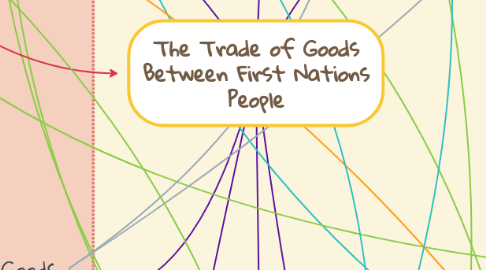
1. Trade Economy
1.1. The First Nations' trade economy was kicked off by the salmon trade.
1.1.1. The Salmon that was readily available at the coast was traded to groups that didn't have a salmon population
1.2. From the fish came Oolichan Grease.
1.2.1. Oolichan Grease was traded through large, two meter wide trails all across B.C. named, "Grease Trails"
2. Trading for Status Goods
2.1. Dentalium
2.1.1. For thousands of years it has been traded to people as far away as the sub-Arctic and the Plains.
2.1.2. a small tusk-like shell which is found only in sub-tidal waters on the west coast of Vancouver Island in Nuu-chah-nulth and Kwakwaka’wakw territory.
2.2. Copper
2.2.1. A rare and extremely valuable resource because it is soft enough to be easily shaped.
2.2.2. Only one source of copper for the B.C. First Nations, the Copper River in the interior of Alaska.
2.2.3. The Tlingit, who live on the Alaskan panhandle, were the intermediaries in the copper trade along the coast.
2.2.4. its most important use was for the large shieldlike objects called coppers. These were the ultimate symbol of wealth for the Northwest Coast tribes. They were displayed and given away at potlatches.
2.3. Slaves were a status good, showing a groups prowess in Combat, along with being free help in the village. Slaves were traded between groups like currency.
3. Goods were traded over large distances by being traded from village to village
4. Mediums of Exchange
4.1. With such complex trading networks mediums of trade were used as a basis of what something was worth. For instance, on the North Coast and the Skeena region, groundhog skins and elk skins were a kind of currency.
4.2. The shell dentalium was widely used as currency across what are now western Canada and the United States.
5. The Potlach
5.1. The feast will draw upon the economic resources of the kin group, especially if the guests will include chiefs from other villages or nations. They pool the food and material goods which they have collected from their territories, or which they have earned in trade.
5.2. The potlatch integrates the spiritual, political, economic, and social dimensions of a community’s life, it is a complex institution based on the idea of giving.
5.3. A potlatch is always initiated for a specific purpose, usually to mark an essential milestone in the life of the family or clan, such as a boy’s first kill, a marriage, and other important events.
5.4. The most impressive and costly potlatches were those where chiefs from neighbouring villages or nations were invited.
6. Gatherings
6.1. Gatherings were important socially and economically, and were usually festive and greatly anticipated throughout the year.
6.2. Some gatherings were meetings of family groups who were related to each other; others brought together people from different nations.
6.3. Often gatherings were associated with food harvesting.
6.3.1. Different Okanagan groups gathered each year at a few key fishing sites such as Kettle Falls, Okanagan Falls, and Shuswap Falls. These gatherings could last throughout the salmon season, sometimes from June to October. As well as catching and drying the fish, people traded and competed in games such as lahal and horse or foot racing.
7. Resources differed so vastly between the interior and coat that demand for items not available locally led to trade.
8. Obsidian
8.1. Obsidian was used to make micro blades, spears, arrows, etc.
8.2. Obsidian came from two sources within British Columbia, and one in Oregon. Within B.C. it was found in Mt. Edziza and Anahim Peak.
8.3. The Obsidian trade has been going strong for over 8,000 years.
9. Trade took place mostly between neighboring nations due to the different resources being available from area to area.
9.1. One example of this is the Nuuchah-nulth, who traded dried halibut, herring, and cedar baskets to the Coast Salish of Vancouver Island in exchange for camas bulbs and swamp rushes for mats. The soapberry or soopolallie, a common plant in the interior but non-existent on the coast, was frequently traded.
9.1.1. The berries can be whipped into a froth that makes a treat sometimes referred to as “Indian ice cream.” The berry and other parts of the plant are also important herbal medicines. So soapberries were, and still are, traded by interior people for foods from the sea, such as dried cockles or herring spawn.

